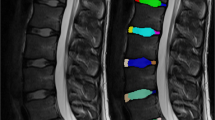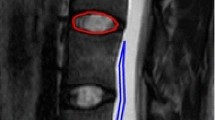Abstract
Introduction
Parallel imaging techniques such as GRAPPA have been introduced to optimize image quality and acquisition time. For spinal imaging in a clinical setting no data exist on the equivalency of conventional and parallel imaging techniques. The purpose of this study was to determine whether T1- and T2-weighted GRAPPA sequences are equivalent to conventional sequences for the evaluation of degenerative lumbar spine disease in terms of image quality and artefacts.
Methods
In patients with clinically suspected degenerative lumbar spine disease two neuroradiologists independently compared sagittal GRAPPA (acceleration factor 2, time reduction approximately 50%) and non-GRAPPA images (25 patients) and transverse GRAPPA (acceleration factor 2, time reduction approximately 50%) and non-GRAPPA images (23 lumbar segments in six patients). Comparative analyses included the minimal diameter of the spinal canal, disc abnormalities, foraminal stenosis, facet joint degeneration, lateral recess, nerve root compression and osteochondrotic vertebral and endplate changes. Image inhomogeneity was evaluated by comparing the nonuniformity in the two techniques. Image quality was assessed by grading the delineation of pathoanatomical structures. Motion and aliasing artefacts were classified from grade 1 (severe) to grade 5 (absent).
Results
There was no significant difference between GRAPPA and non-accelerated MRI in the evaluation of degenerative lumbar spine disease (P > 0.05), and there was no difference in the delineation of pathoanatomical structures. For inhomogeneity there was a trend in favour of the conventional sequences. No significant artefacts were observed with either technique.
Conclusion
The GRAPPA technique can be used effectively to reduce scanning time in patients with degenerative lumbar spine disease while preserving image quality.

Similar content being viewed by others
References
Sodickson DK, Griswold MA, Jakob PM, Edelman RR, Manning WJ (1999) Signal-to-noise ratio and signal-to-noise efficiency in SMASH imaging. Magn Reson Med 5:1009–1022
Pruessmann KP, Weiger M, Scheidegger MB, Boesiger P (1999) SENSE: sensitivity encoding for fast MRI. Magn Reson Med 5:952–962
Larkman DJ, Nunes RG (2007) Parallel magnetic resonance imaging. Phys Med Biol 7:R15–R55
Griswold MA, Jakob PM, Heidemann RM, Nittka M, Jellus V, Wang J, Kiefer B, Haase A (2002) Generalized autocalibrating partially parallel acquisitions (GRAPPA). Magn Reson Med 6:1202–1210
Ruel L, Brugieres P, Luciani A, Breil S, Mathieu D, Rahmouni A (2004) Comparison of in vitro and in vivo MRI of the spine using parallel imaging. AJR Am J Roentgenol 3:749–755
Noebauer-Huhmann IM, Glaser C, Dietrich O, Wallner CP, Klinger W, Imhof H, Schoenberg SO (2007) MR imaging of the cervical spine: assessment of image quality with parallel imaging compared to non-accelerated MR measurements. Eur Radiol 5:1147–1155
Cohen JA (1960) A coefficient of agreement for nominal scales. Educ Psychol Meas 20:37–46
Landis JR, Koch GG (1977) The measurement of observer agreement for categorical data. Biometrics 1:159–174
Brant-Zawadzki MN, Jensen MC, Obuchowski N, Ross JS, Modic MT (1995) Interobserver and intraobserver variability in interpretation of lumbar disc abnormalities. A comparison of two nomenclatures. Spine 11:1257–1263; discussion 1264
Masaryk TJ, Ross JS, Modic MT, Boumphrey F, Bohlman H, Wilber G (1988) High-resolution MR imaging of sequestered lumbar intervertebral disks. AJR Am J Roentgenol 5:1155–1162
Wildermuth S, Zanetti M, Duewell S, Schmid MR, Romanowski B, Benini A, Boni T, Hodler J (1998) Lumbar spine: quantitative and qualitative assessment of positional (upright flexion and extension) MR imaging and myelography. Radiology 2:391–398
Kettler A, Wilke HJ (2006) Review of existing grading systems for cervical or lumbar disc and facet joint degeneration. Eur Spine J 6:705–718
Weishaupt D, Zanetti M, Boos N, Hodler J (1999) MR imaging and CT in osteoarthritis of the lumbar facet joints. Skeletal Radiol 4:215–219
Pfirrmann CW, Dora C, Schmid MR, Zanetti M, Hodler J, Boos N (2004) MR image-based grading of lumbar nerve root compromise due to disk herniation: reliability study with surgical correlation. Radiology 2:583–588
Jenis LG, An HS (2000) Spine update. Lumbar foraminal stenosis. Spine 3:389–394
Modic MT, Steinberg PM, Ross JS, Masaryk TJ, Carter JR (1988) Degenerative disk disease: assessment of changes in vertebral body marrow with MR imaging. Radiology 1 Pt 1:193–199
Modic MT, Masaryk TJ, Ross JS, Carter JR (1988) Imaging of degenerative disk disease. Radiology 1:177–186
Dietrich O, Reeder S, Reiser M, Schoenberg SO (2005) Influence of parallel imaging and other reconstruction techniques on the measurement of signal-to-noise-ratio. Presentation 158. Proceedings of the ISMRM 13th Scientific Meeting, Miami, FL, 7–13 May 2005
Wicks DA, Barker GJ, Tofts PS (1993) Correction of intensity nonuniformity in MR images of any orientation. Magn Reson Imaging 2:183–196
Li T, Mirowitz SA (2002) Comparative study of fast MR imaging: quantitative analysis on image quality and efficiency among various time frames and contrast behaviors. Magn Reson Imaging 6:471–478
Ross JS, Ruggieri P, Tkach J, Obuchowski N, Dillinger J, Masaryk TJ, Modic MT (1993) Lumbar degenerative disk disease: prospective comparison of conventional T2-weighted spin-echo imaging and T2-weighted rapid acquisition relaxation-enhanced imaging. AJNR Am J Neuroradiol 5:1215–1223
Romaneehsen B, Oberholzer K, Muller LP, Kreitner KF (2003) Rapid musculoskeletal magnetic resonance imaging using integrated parallel acquisition techniques (IPAT) – initial experiences. Rofo 9:1193–1197
Sodickson DK, Manning WJ (1997) Simultaneous acquisition of spatial harmonics (SMASH): fast imaging with radiofrequency coil arrays. Magn Reson Med 4:591–603
Sodickson DK, Griswold MA, Jakob PM (1999) SMASH imaging. Magn Reson Imaging Clin N Am 2:237–254, vii–viii
Bydder M, Larkman DJ, Hajnal JV (2002) Generalized SMASH imaging. Magn Reson Med 1:160–170
Eichinger M, Puderbach M, Fink C, Gahr J, Ley S, Plathow C, Tuengerthal S, Zuna I, Muller FM, Kauczor HU (2006) Contrast-enhanced 3D MRI of lung perfusion in children with cystic fibrosis – initial results. Eur Radiol 10:2147–2152
Tintera J, Gawehn J, Bauermann T, Vucurevic G, Stoeter P (2004) New partially parallel acquisition technique in cerebral imaging: preliminary findings. Eur Radiol 12:2273–2281
Riedy G, Golay X, Melhem ER (2005) Three-dimensional isotropic contrast-enhanced MR angiography of the carotid artery using sensitivity-encoding and random elliptic centric k-space filling: technique optimization. Neuroradiology 9:668–673
Summers PE, Kollias SS, Valavanis A (2004) Resolution improvement in thick-slab magnetic resonance digital subtraction angiography using SENSE at 3T. J Magn Reson Imaging 4:662–673
Meckel S, Mekle R, Taschner C, Haller S, Scheffler K, Radue EW, Wetzel SG (2006) Time-resolved 3D contrast-enhanced MRA with GRAPPA on a 1.5-T system for imaging of craniocervical vascular disease: initial experience. Neuroradiology 5:291–299
Preibisch C, Pilatus U, Bunke J, Hoogenraad F, Zanella F, Lanfermann H (2003) Functional MRI using sensitivity-encoded echo planar imaging (SENSE-EPI). Neuroimage 2 Pt 1:412–421
Skare S, Newbould RD, Clayton DB, Albers GW, Nagle S, Bammer R (2007) Clinical multishot DW-EPI through parallel imaging with considerations of susceptibility, motion, and noise. Magn Reson Med 5:881–890
Bock M, Muller S, Zuehlsdorff S, Speier P, Fink C, Hallscheidt P, Umathum R, Semmler W (2006) Active catheter tracking using parallel MRI and real-time image reconstruction. Magn Reson Med 6:1454–1459
Author information
Authors and Affiliations
Corresponding author
Additional information
Conflict of interest statement
We declare that we have no conflict of interest.
Rights and permissions
About this article
Cite this article
Nölte, I., Gerigk, L., Brockmann, M.A. et al. MRI of degenerative lumbar spine disease: comparison of non-accelerated and parallel imaging. Neuroradiology 50, 403–409 (2008). https://doi.org/10.1007/s00234-008-0363-0
Received:
Accepted:
Published:
Issue Date:
DOI: https://doi.org/10.1007/s00234-008-0363-0




